A) ability-to-pay
B) regressive tax
C) progressive tax
D) benefits
Correct Answer

verified
Correct Answer
verified
Multiple Choice
Use the following to answer question: 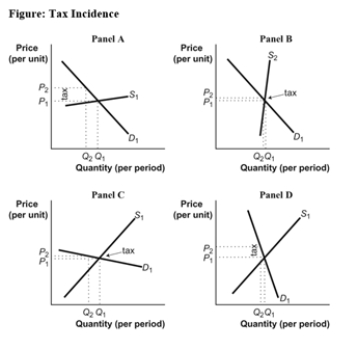 -(Figure: Tax Incidence) Use Figure: Tax Incidence.Based on the figure,the deadweight loss of an excise tax is likely to be greater in panel _____ than in panel _____.
-(Figure: Tax Incidence) Use Figure: Tax Incidence.Based on the figure,the deadweight loss of an excise tax is likely to be greater in panel _____ than in panel _____.
A) D;C
B) A;B
C) C;B
D) B;A
Correct Answer

verified
Correct Answer
verified
Multiple Choice
Use the following to answer question: 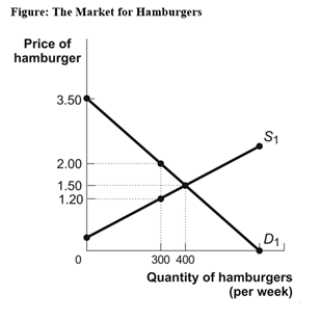 -(Figure: The Market for Hamburgers) Use Figure: The Market for Hamburgers.If the market is originally in equilibrium and the government imposes an excise tax of $0.80 per unit of the good sold,the deadweight loss associated with the tax will be:
-(Figure: The Market for Hamburgers) Use Figure: The Market for Hamburgers.If the market is originally in equilibrium and the government imposes an excise tax of $0.80 per unit of the good sold,the deadweight loss associated with the tax will be:
A) $40.
B) $240.
C) $105.
D) $90.
Correct Answer

verified
Correct Answer
verified
Multiple Choice
Given any downward-sloping demand curve for a good,the more inelastic the supply curve,the _____ equilibrium output will fall and the _____ will be the deadweight loss when the government imposes an excise tax.
A) more;smaller
B) more;larger
C) less;smaller
D) less;larger
Correct Answer

verified
Correct Answer
verified
Multiple Choice
A principle suggesting that people with more income or wealth should pay more taxes is the _____ principle.
A) ability-to-pay
B) proportional tax
C) lump-sum tax
D) benefits received
Correct Answer

verified
Correct Answer
verified
Multiple Choice
Tax incidence refers to:
A) who writes the check to the government.
B) who really pays the tax.
C) the deadweight loss from the tax.
D) the total revenue that the government collects from the tax.
Correct Answer

verified
Correct Answer
verified
Multiple Choice
Use the following to answer question: 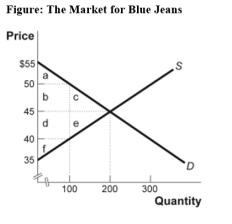 -(Figure: The Market for Blue Jeans) Use Figure: The Market for Blue Jeans.The government recently levied a $10 tax on the producers of blue jeans.What area or areas in the graph identify the loss of consumer surplus due to the tax?
-(Figure: The Market for Blue Jeans) Use Figure: The Market for Blue Jeans.The government recently levied a $10 tax on the producers of blue jeans.What area or areas in the graph identify the loss of consumer surplus due to the tax?
A) c
B) b + c
C) b
D) a + b + c
Correct Answer

verified
Correct Answer
verified
Multiple Choice
Consumers in a particular market will bear the greater burden of an excise tax:
A) the more price-elastic supply is relative to demand.
B) the less price-elastic supply is relative to demand.
C) if supply has the same price elasticity as demand.
D) regardless of the price elasticity of demand or supply.
Correct Answer

verified
Correct Answer
verified
Multiple Choice
According to the _____ principle,those who can afford it should pay higher tax.
A) ability-to-pay
B) tax fairness
C) benefits
D) affordability
Correct Answer

verified
Correct Answer
verified
True/False
If the government imposes a $500 excise tax on SUVs and the demand curve for SUVs is downward-sloping,suppliers of SUVs will simply raise the price by $500 and consumers will bear the entire burden of the tax.
Correct Answer

verified
Correct Answer
verified
Multiple Choice
An excise tax causes inefficiency if the number of transactions in a market is reduced as a result of the tax.Because the tax discourages mutually beneficial transactions,there is a(n) _____ from a tax.
A) quota rent
B) deadweight loss
C) increased consumer surplus
D) increased producer surplus
Correct Answer

verified
Correct Answer
verified
Multiple Choice
If demand is perfectly inelastic and the supply curve is upward-sloping,then the burden of an excise tax is:
A) borne entirely by consumers.
B) borne entirely by producers.
C) shared by consumers and producers,with the burden falling mainly on consumers.
D) shared by consumers and producers,with the burden falling mainly on producers.
Correct Answer

verified
Correct Answer
verified
Multiple Choice
The price elasticity of demand for a particular cancer drug is zero and the price elasticity of supply is 0.50.If a $1 excise tax is levied on producers,how much of this tax will eventually be paid by consumers?
A) $0
B) $1
C) $0.50
D) $1.50
Correct Answer

verified
Correct Answer
verified
Multiple Choice
Use the following to answer question: 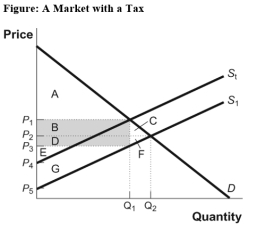 -(Figure: A Market with a Tax) Use Figure: A Market with a Tax.The deadweight loss arising from the imposition of this tax is equal to the areas:
-(Figure: A Market with a Tax) Use Figure: A Market with a Tax.The deadweight loss arising from the imposition of this tax is equal to the areas:
A) B + D
B) D + E.
C) B + C.
D) C + F.
Correct Answer

verified
Correct Answer
verified
Multiple Choice
If demand and supply are both very inelastic,a decrease in the rate of an excise tax will likely:
A) decrease government revenue.
B) increase government revenue.
C) not affect government revenue.
D) make demand and supply both elastic.
Correct Answer

verified
Correct Answer
verified
Multiple Choice
A tax system achieves equity when:
A) taxes are distributed fairly,however society may define fair.
B) it minimizes the costs to the economy of tax collection.
C) it is efficient.
D) taxes are lump sum.
Correct Answer

verified
Correct Answer
verified
Multiple Choice
Use the following to answer question: 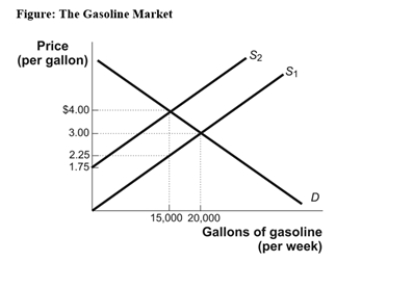 -(Figure: The Gasoline Market) Use Figure: The Gasoline Market.The pretax equilibrium price is $3,and the equilibrium quantity before tax is 20,000 gallons.An excise tax has been levied on each gallon of gasoline supplied by producers,shifting the supply curve upward.The total tax revenue collected by the government is equal to:
-(Figure: The Gasoline Market) Use Figure: The Gasoline Market.The pretax equilibrium price is $3,and the equilibrium quantity before tax is 20,000 gallons.An excise tax has been levied on each gallon of gasoline supplied by producers,shifting the supply curve upward.The total tax revenue collected by the government is equal to:
A) $1.50.
B) $15,000.
C) $26,250.
D) $30,000.
Correct Answer

verified
Correct Answer
verified
Multiple Choice
If the demand for good X is perfectly inelastic and a tax is levied on the producers of each unit:
A) consumers pay the entire tax,and deadweight loss will occur because the equilibrium quantity of good X falls.
B) consumers pay the entire tax,and there is no deadweight loss because the equilibrium quantity of good X remains constant.
C) consumers and producers share the burden of the tax,and there is no deadweight loss because the equilibrium quantity of good X remains constant.
D) producers pay the entire tax,and deadweight loss will occur because the equilibrium quantity of good X falls.
Correct Answer

verified
Correct Answer
verified
Multiple Choice
Use the following to answer question:  -(Figure: Tax Incidence) Use Figure: Tax Incidence.All other things unchanged,when a good or service is characterized by a relatively inelastic supply,as shown in panel _____,a greater share of the burden of an excise tax is borne by _____.
-(Figure: Tax Incidence) Use Figure: Tax Incidence.All other things unchanged,when a good or service is characterized by a relatively inelastic supply,as shown in panel _____,a greater share of the burden of an excise tax is borne by _____.
A) A;buyers
B) B;sellers
C) A;sellers
D) B;buyers
Correct Answer

verified
Correct Answer
verified
Multiple Choice
If personal income up to and including $30,000 is not taxed,income of $30,001 to $60,000 is taxed at 10%,and income over $60,000 is taxed at 25%,then a family earning an income of $100,000 will pay _____ in personal taxes.
A) $6,000
B) $10,000
C) $13,000
D) $25,000
Correct Answer

verified
Correct Answer
verified
Showing 181 - 200 of 286
Related Exams